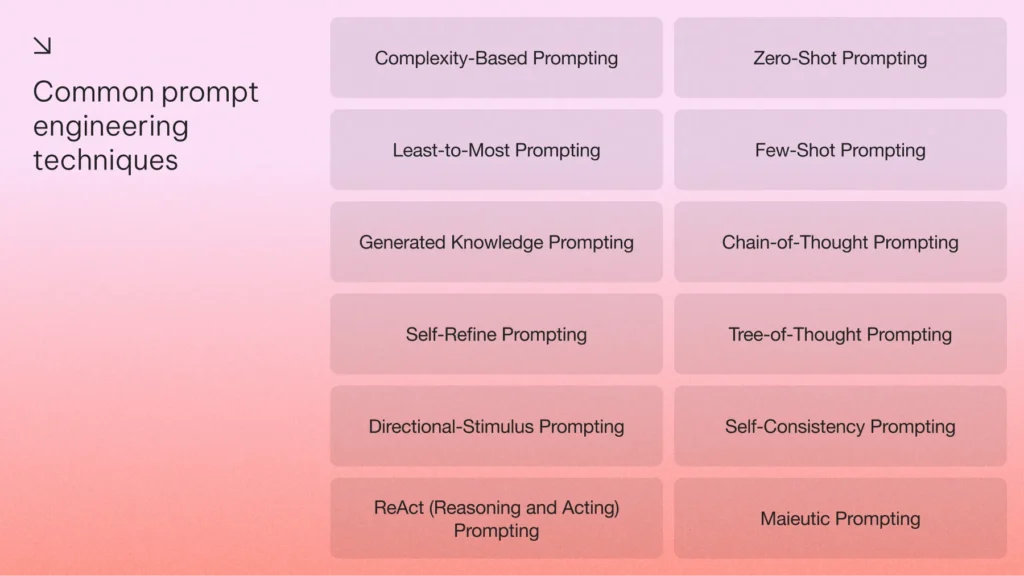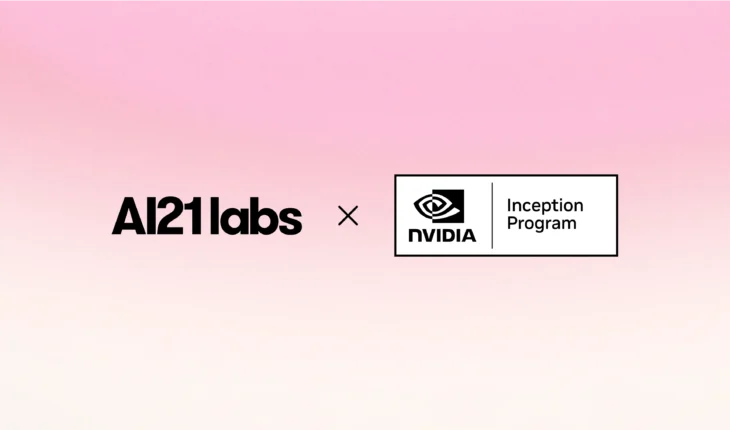Table of Contents

What is Prompt Engineering? Techniques & Use Cases
72% of companies worldwide use AI in at least one business function, but as use cases grow, so does the need for AI to meet exacting enterprise requirements, mainly when using Large Language Models (LLMs).
Prompt engineering is a technique that provides instructions for AI models to produce better outputs. It’s a huge growth area, with the market projected to grow at a CAGR of 32.8% from 2024 to 2030.
In this article, we will explain why prompt engineering is essential, describe the kinds of prompts available, and discuss considerations for enterprise prompt engineering.
What is prompt engineering?
Prompt engineering is the strategic craft of designing, refining, and optimizing instructions given to AI language models to elicit precise, accurate, and useful responses. When working with Large Language Models (LLMs), the quality of your input directly influences the quality of the output you receive.
At its core, prompt engineering involves providing AI systems with:
- Clear contextual information that frames the task
- Specific instructions that guide the model’s processing
- Appropriate constraints that focus the response
- Relevant examples that demonstrate desired patterns
Effective prompt engineering reduces ambiguity, minimizes hallucinations, and creates shortcuts in the model’s reasoning process. This leads to more efficient interactions, faster problem-solving, and responses better aligned with user intentions.
Why is prompt engineering important?
Prompt engineering enhances AI accuracy, reduces response time, and ensures AI tools function reliably, making them more useful for complex enterprise tasks.
A poorly designed prompt will not respond correctly, no matter how much it’s repeated. In contrast, a well-optimized prompt can get the answer faster, reducing frustration and computational costs by minimizing unnecessary iterations.
Additional advantages include:
- Reduced bias: Well-structured prompts can help counteract inherent biases in AI models by clearly defining perspectives or contextual requirements, leading to more balanced outputs.
- Versatility: Prompt engineering allows users to fine-tune AI responses for specific tasks and industries so the system comprehends goals that align with the department or sector in which it’s used.
- Faster results: Refining prompts improves AI-generated results from the outset, allowing the AI to focus on more complex tasks.
- Environmental benefits: The environmental and energy costs of using LLMs have been well documented. Precise prompts reduce the computational power required.
What are common prompt engineering techniques?
There are various prompt engineering techniques to gain improved responses, tailored outputs, and more structured answers. Pick a method, prompt an LLM, and observe how the response differs from a basic prompt.

Zero-Shot Prompting
Zero-shot prompting is where the user provides an LLM with direct instruction or questions without additional context for quick, general knowledge retrieval. It’s great to gauge what the AI already “knows” before refining responses with more context.
- Example: “Who are our competitors? Provide a concise and general response based on existing knowledge.”
Few-Shot Prompting
This involves providing the model with a few contextual examples before asking it to perform a similar task. It is useful when providing clear instructions is difficult or the model does not fully understand them.
- Example: “Here are two case studies for my sector. Now provide the framework for a third.”
Chain-of-Thought Prompting
An advanced technique in which a large language model (LLM) is prompted to take multiple steps to solve one problem and provides its reasoning for problem-solving, analysis, and structured explanations.
- Example: “Explain how to handle issues in stock management. Break it down into three key steps before giving a final summary.”
Tree-of-Thought Prompting
While Chain-of-Thought prompting leads to linear reasoning, Tree-of-Thought Prompting can explore multiple reasoning paths in parallel to offer the best option.
- Example: “To evaluate the best strategy for reducing customer churn. Compare three approaches (personalized marketing, loyalty programs, and customer feedback) before recommending the most effective option.”
Self-Consistency Prompting
Self-consistency prompting occurs when, instead of providing a single answer, the AI generates multiple responses for the same question using different reasoning paths or methods to identify the most consistent and reliable one.
- Example: “What was our gross profit last year? Pre-load the question asking to ‘generate multiple independent answers using different reasoning approaches. Then, compare the answers and identify the most consistent and reliable response before finalizing your answer.”
Maieutic Prompting
This prompting model asks AI to explain answers for better accuracy to delve deeper into the model’s rationale behind its response.
- Example: “Why should we follow this strategy?” or “How will we know it’s worked?”
Complexity-Based Prompting
This is a method in which the prompts are intentionally more complex and require multiple steps of reasoning instead of simple, straightforward thinking.
- Example: “A company is considering an investment in a new technology that costs $10 million. Should the company proceed? Consider risk, market trends, and opportunity costs before recommending.”
Least-to-Most Prompting
Least-to-most prompting is where a prompt is structured progressively, allowing AI to build step-by-step reasoning.
- Example: Instead of asking, “How should a bank structure loan terms?” the LLM must first answer, “What factors influence loan approval?” and then, “How do lenders assess loan risk?” before tackling the final complex question.
Generated Knowledge Prompting
This improves the reliability of AI responses by encouraging the model to generate background knowledge before directly answering a question.
- Example: “Before answering, provide background knowledge on AI’s role in logistics, including examples and challenges. Then, answer: Can AI improve our warehouse issues?”
Self-Refine Prompting
With this technique, an AI model reviews and improves its answers, generating an initial response about evaluating its answer for weakness in logic or accuracy before providing a finalized response.
- Example: “Answer the following question, then critically evaluate your response for weaknesses in logic, missing details, or lack of depth. Identify at least two areas for improvement and refine your response accordingly before presenting the final answer.”
Directional-Stimulus Prompting
This response is steered in the right direction by leaving extra information as to what the answer should include.
- Example: Instead of asking how to improve email open rates and risk a generic response that doesn’t consider brand reputation, ask, “How can a brand improve email marketing by increasing open rates and click-through rates while maintaining brand consistency?”
ReAct (Reasoning and Acting) Prompting
This technique helps AI reason step by step, act on this reasoning, and update a response based on information.
- Example: “How can we optimize inventory management to reduce stock shortages and excess inventory? Solve the problem step by step. First, analyze relevant information and break down key factors. Then, take an action based on this reasoning.”
Prompt engineering use cases for the enterprise
Prompt engineering enhances responses and can, as such, be used across many enterprise areas, both for external and internal benefit.
Developing intelligent chatbots for automated customer support
Prompt engineering helps power AI chatbots for customer support by training them to recognize client difficulties and offer information. By providing prompts in many ways, it’s possible to predict many different approaches to information requests, generating better responses.
Generating personalized responses to customer inquiries
AI’s ability to interpret and address customer needs hinges on well-engineered prompts that provide the necessary context and direction. Prompts with context, such as asking the system to analyze past behavior, preferences, and sentiment, ensure more tailored responses that feel natural and relevant.
Providing real-time product recommendations
Prompt engineering can improve customer retention and engagement by suggesting products based on purchase history, increasing conversion rates and customer satisfaction by making interactions more engaging and personalized.
Generating new product ideas
Using prompt engineering, enterprises can generate new product ideas by analyzing current market trends, identifying unmet consumer needs, and predicting future demand. In addition to concept production, prompt engineering can help refine designs and enhance go-to-market strategies, reducing development time and improving market success rates.
Analyzing large datasets
Language models can analyze data automatically and produce insights with natural language prompts. By using the correct prompts to process vast amounts of data efficiently, enterprises can start uncovering trends, patterns, and actionable insights.
Key considerations for enterprise prompt engineering
Like when deploying large language models, businesses must consider the following critical factors when implementing effective prompt engineering to fully leverage AI’s capabilities.
Data Security
Prompt engineering must prioritize data security and compliance with regulations like GDPR and CCPA. Sensitive information or examples should be anonymized or restricted, ensuring AI interactions protect user privacy. Other options include implementing encryption, access controls, and ethical AI frameworks.
Bias mitigation
Proper prompt engineering ensures AI delivers responses that avoid perpetuating stereotypes.
Enterprise-level prompt engineering should include prompts that encourage diverse perspectives and incorporate human feedback loops to minimize detrimental responses.
Prompt optimization
Well-structured prompts must guide AI toward desired outcomes, reducing ambiguity and enhancing user experience. It’s key to experiment with different formats, iterate based on results, and continuously refine prompts.
Prompt engineering: Your business’s AI advantage
Prompt engineering is an evolving discipline, and businesses that master it early will gain a significant edge.
As AI advances, enterprises must refine their interactions with AI models, ensuring efficiency, accuracy, and strategic alignment.
The learning curve is steep, but those who invest in structured prompt engineering now will lead the future of AI-driven business operations.


